A multicomponent RNA-based control system regulates subgenomic mRNA transcription in a tombusvirus
- PMID: 17166897
- PMCID: PMC1865963
- DOI: 10.1128/JVI.01969-06
A multicomponent RNA-based control system regulates subgenomic mRNA transcription in a tombusvirus
Abstract
During infections, positive-strand RNA tombusviruses transcribe two subgenomic (sg) mRNAs that allow for the expression of a subset of their genes. This process is thought to involve an unconventional mechanism involving the premature termination of the virally encoded RNA-dependent RNA polymerase while it is copying the virus genome. The 3' truncated minus strands generated by termination are then used as templates for sg mRNA transcription. In addition to requiring an extensive network of long-distance RNA-RNA interactions (H.-X. Lin and K. A. White, EMBO J. 23:3365-3374, 2004), the transcription of tombusvirus sg mRNAs also involves several additional RNA structures. In vivo analysis of these diverse RNA elements revealed that they function at distinct steps in the process by facilitating the formation or stabilization of the long-distance interactions, modulating minus-strand template production, or promoting the initiation of sg mRNA transcription. All of the RNA elements characterized could be readily incorporated into a premature termination model for sg mRNA transcription. Overall, the analyses revealed a complex system that displays a high level of structural integration and functional coordination. This multicomponent RNA-based control system may serve as a useful paradigm for understanding related transcriptional processes in other positive-sense RNA viruses.
Figures
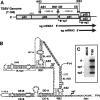
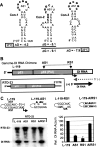
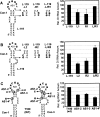

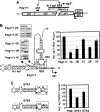


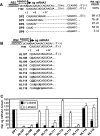

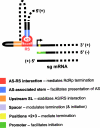
Similar articles
-
Uncoupling RNA virus replication from transcription via the polymerase: functional and evolutionary insights.EMBO J. 2007 Dec 12;26(24):5120-30. doi: 10.1038/sj.emboj.7601931. Epub 2007 Nov 22. EMBO J. 2007. PMID: 18034156 Free PMC article.
-
A complex network of RNA-RNA interactions controls subgenomic mRNA transcription in a tombusvirus.EMBO J. 2004 Aug 18;23(16):3365-74. doi: 10.1038/sj.emboj.7600336. Epub 2004 Jul 29. EMBO J. 2004. PMID: 15282544 Free PMC article.
-
Subgenomic mRNA transcription in an aureusvirus: down-regulation of transcription and evolution of regulatory RNA elements.Virology. 2008 Feb 20;371(2):430-8. doi: 10.1016/j.virol.2007.09.035. Epub 2007 Nov 7. Virology. 2008. PMID: 17988704
-
Advances in the molecular biology of tombusviruses: gene expression, genome replication, and recombination.Prog Nucleic Acid Res Mol Biol. 2004;78:187-226. doi: 10.1016/S0079-6603(04)78005-8. Prog Nucleic Acid Res Mol Biol. 2004. PMID: 15210331 Review.
-
Subgenomic mRNA transcription in Tombusviridae.RNA Biol. 2011 Mar-Apr;8(2):287-94. doi: 10.4161/rna.8.2.15195. Epub 2011 Mar 1. RNA Biol. 2011. PMID: 21422816 Review.
Cited by
-
Metagenomic identification of novel viruses of maize and teosinte in North America.BMC Genomics. 2022 Nov 23;23(1):767. doi: 10.1186/s12864-022-09001-w. BMC Genomics. 2022. PMID: 36418948 Free PMC article.
-
Identification of a coronavirus transcription enhancer.J Virol. 2008 Apr;82(8):3882-93. doi: 10.1128/JVI.02622-07. Epub 2008 Feb 13. J Virol. 2008. PMID: 18272586 Free PMC article.
-
Global organization of a positive-strand RNA virus genome.PLoS Pathog. 2013;9(5):e1003363. doi: 10.1371/journal.ppat.1003363. Epub 2013 May 23. PLoS Pathog. 2013. PMID: 23717202 Free PMC article.
-
Uncoupling RNA virus replication from transcription via the polymerase: functional and evolutionary insights.EMBO J. 2007 Dec 12;26(24):5120-30. doi: 10.1038/sj.emboj.7601931. Epub 2007 Nov 22. EMBO J. 2007. PMID: 18034156 Free PMC article.
-
RNA-based regulation of transcription and translation of aureusvirus subgenomic mRNA1.J Virol. 2009 Oct;83(19):10096-105. doi: 10.1128/JVI.00376-09. Epub 2009 Jul 15. J Virol. 2009. PMID: 19605481 Free PMC article.
References
-
- Choi, I. R., M. Ostrovsky, G. Zhang, and K. A. White. 2001. Regulatory activity of distal and core RNA elements in tombusvirus subgenomic mRNA2 transcription. J. Biol. Chem. 276:41761-41768. - PubMed
-
- Choi, I. R., and K. A. White. 2002. An RNA activator of subgenomic mRNA1 transcription in tomato bushy stunt virus. J. Biol. Chem. 277:3760-3766. - PubMed
-
- Fabian, M. R., H. Na, D. Ray, and K. A. White. 2003. 3′-terminal RNA secondary structures are important for accumulation of tomato bushy stunt virus DI RNAs. Virology 313:567-580. - PubMed
-
- Fabian, M. R., and K. A. White. 2004. 5′-3′ RNA-RNA interaction facilitates cap- and poly(A) tail-independent translation of tomato bushy stunt virus mRNA: a potential common mechanism for Tombusviridae. J. Biol. Chem. 279:28862-28872. - PubMed
Publication types
MeSH terms
Substances
LinkOut - more resources
Full Text Sources

